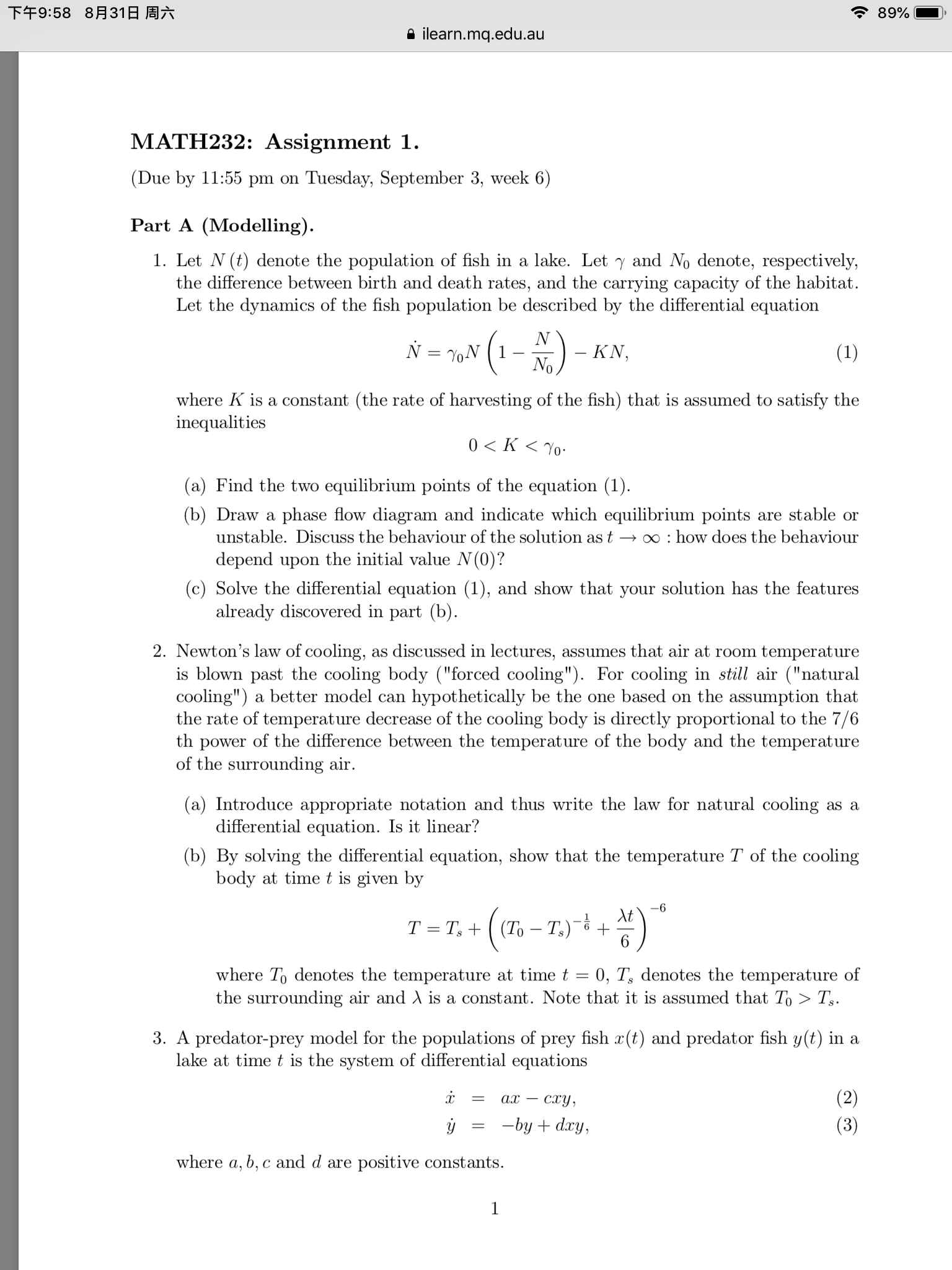Math232 : answer with process and detail plz, due on Tuesday 3/9
'F'F9258 8H31EI Elf: '6' 89%EJ' n ilearn.mq.edu.au MATH232: Assignment 1. (Due by 11:55 pm on Tuesday, September 3, week 6) Part A (Modelling). 1. Let N (t) denote the population of sh in a lake. Let y and N0 denote, reSpectively, the difference between birth and death rates, and the carrying capacity of the habitat. Let the dynamics of the sh population be described by the differential equation . N N = yoN (1 ) KN, (1) No where K is a constant (the rate of harvesting of the sh) that is assumed to satisfy the inequalities 0 oo 2 how does the behaviour depend upon the initial value N (0)? (c) Solve the differential equation (1), and show that your solution has the features already discovered in part (b). 2. Newton's law of cooling, as discussed in lectures, assumes that air at room temperature is blown past the cooling body ("forced cooling"). For cooling in still air ("natural cooling") a better model can hypothetically be the one based on the assumption that the rate of temperature decrease of the cooling body is directly proportional to the 7/ 6 th power of the difference between the temperature of the body and the temperature of the surrounding air. (a) Introduce appropriate notation and thus write the law for natural cooling as a differential equation. Is it linear? (b) By solving the differential equation, show that the temperature T of the cooling body at time t is given by 6 T = Ts + ((T0 Ts) + %) where To denotes the temperature at time t = 0, Ts denotes the temperature of the surrounding air and A is a constant. Note that it is assumed that To > T5. 3. A predator-prey model for the populations of prey sh 33(t) and predator sh y(t) in a lake at time t is the system of differential equations 3': as): any, (2) 3) = by + dmy, (3) where a, b, c and d are positive constants. 1 'FF9:58 8H31El Bin '5' 88%E1' n ilearn.mq.edu.au (a) Explain the meaning and signicance of the constants a and b for the model. (b) In the absence of predators (that is, when y (t) E 0) what happens to the number of prey as t > 00? (c) Show that there is exactly one equilibrium point (51:0, yo) in the system (2)7(3) in which both can and ya are positive. (d) Suppose that predator sh is removed from the lake at a rate K 3;, that is, at a rate proportional to the number of predators, where K is a positive constant. Modify the system (2)7(3) to incorporate the removal of the predator sh, and determine the new equilibrium point (:61, yl). Comment on the effect of removing predator sh on the equilibrium levels of each species. (e) Let (3:1, yl) be the equilibrium solution obtained in part (d) Set it (t) = 512(15) 3:1 and v (t) = y (t) yl. Determine the system of differential equations satised by u and v. (f) Now suppose that u and v are small (so that m and y are near the equilibrium solution). Consider the system obtained by neglecting all terms that are small compared to u or a. Show that the function u (t) then satises a second order linear differential equation. By solving this equation, show that the functions 1.; and v are periodic, and determine their periods. Part B (Fourier Analysis). 1. Sketch (on separate gures) the following 2w-periodic functions f (as) and 9(3), which for 1r an cosnx. n= 1 By considering the integral ION (2)12 dx, show that and then (state your arguments) (c) What can be deduced from your answer to part (b) 1. about convergence of the series a? ? n= 1 2. about the coefficients an as n - co? (d) Determine the limit lim & S, f (x) cos na dx. 3









